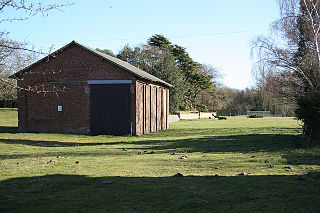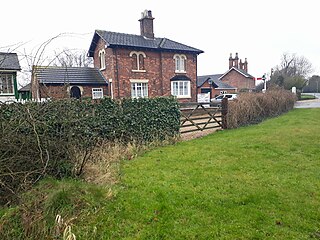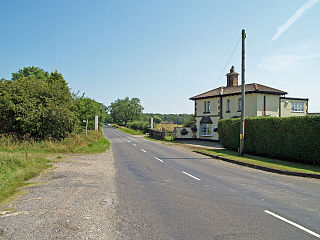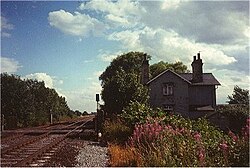
Gainsborough Lea Road railway station is one of two stations that serve the town of Gainsborough in Lincolnshire, England, the other station being Gainsborough Central, which is located in the town centre. The station is managed by East Midlands Railway and is located 14+1⁄4 miles (23 km) northwest of Lincoln Central on the A156 Lea Road in the south of the town. The station opened in 1867 on a single line of the Great Northern Railway, who ran four trains a day from Gainsborough to Lincoln.

Park Bridge Railway Station was a railway station on the Oldham, Ashton-under-Lyne and Guide Bridge Junction Railway (OA&GB) that served the village of Park Bridge, in the Medlock Valley near Ashton-under-Lyne's border with Oldham. It was sometimes known as Parkbridge, and one photograph of the station shows the station name board with the name as one word and immediately adjacent the signal box with it shown as two. The station opened on 26 August 1861 when the line opened.
For other stations named Ashton, see Ashton railway station (disambiguation)

Aby for Claythorpe was a railway station on the East Lincolnshire Railway which served the hamlets of Aby and Claythorpe in Lincolnshire between 1848 and 1961. It originally opened as Claythorpe, but was renamed in 1885. Withdrawal of goods facilities took place in 1961, on the same day that the station was closed to passengers. The line through the station is closed.

Adlestrop railway station was a railway station which served the village of Adlestrop in Gloucestershire, England, between 1853 and 1966. It was on what is now called the Cotswold Line. The station was immortalised in the poem "Adlestrop" by Edward Thomas after his train stopped there on 24 June 1914.

East Ville was a railway station on the East Lincolnshire Railway which served the village of Eastville in Lincolnshire between 1848 and 1964. It originally opened as East Ville and New Leake, but was renamed in 1850. Withdrawal of passenger services took place in 1961, followed by goods facilities in 1964. The line through the station remains in use as the Poacher Line

Little Steeping was a railway station on the East Lincolnshire Railway which served the hamlet of Little Steeping in Lincolnshire between 1848 and 1964. It became a junction station in June 1913 when the Kirkstead and Little Steeping Railway was opened to provide a more direct route to Skegness for East Midlands holidaymakers. Withdrawal of passenger services took place in 1961, followed by goods facilities in 1964. The line through the station remains in use as the Poacher Line, although the Kirkstead and Little Steeping Railway closed throughout on 5 October 1970.

Burgh-le-Marsh was a railway station on the East Lincolnshire Railway which served the town of Burgh le Marsh in Lincolnshire between 1848 and 1970. It originally opened as Burgh, but was renamed in 1923. Withdrawal of goods facilities took place in 1966, followed by passenger services in 1970. The line through the station is now closed.

Alford Town was a railway station on the East Lincolnshire Railway which served the town of Alford in Lincolnshire between 1848 and 1970. It originally opened as Alford, but was renamed in 1923. When passenger services were withdrawn in 1970 the line through the station was closed.

Authorpe was a railway station on the East Lincolnshire Railway, which served the village of Authorpe in Lincolnshire between 1848 and 1964. The station was closed to passengers in 1961, and withdrawal of goods facilities took place in 1964. The line through the station is closed.

Legbourne Road was a railway station on the East Lincolnshire Railway which served the village of Legbourne in Lincolnshire between 1848 and 1964. The station was closed to passengers in 1953, and withdrawal of goods facilities took place in 1964. The line through the station closed in 1970. The station once housed a museum containing railway memorabilia; this closed in 1998 and the building is once again a private residence.
Waltham was a railway station on the East Lincolnshire Railway which served the villages of New Waltham and Humberston in Lincolnshire between 1848 and 1964. It was originally named Waltham and Humberstone, but Humberstone was dropped soon after opening. The line through Waltham remained open for freight until December 1980.

Holton-le-Clay was a railway station on the East Lincolnshire Railway which served the English villages of Holton-le-Clay and Tetney in Lincolnshire between 1848 and 1964. It was originally named Holton-le-Clay and Tetney, but Tetney was dropped soon after opening, even though the station was more conveniently sited for that village. The line through Holton-le-Clay remained open for freight until December 1980, but could be reopened by the Lincolnshire Wolds Railway as its northern terminus.

Fotherby Halt was a railway halt on the East Lincolnshire Railway which served the village of Fotherby in Lincolnshire between 1905 and 1961. The station was opened on the site of a previous station named Fotherby Gate House which had closed in 1872. The second station closed in 1961, but the line through it remained open for freight until December 1980. The line through the station could be reopened by the Lincolnshire Wolds Railway as part of its extension south from Ludborough to Louth.

Egginton Junction railway station is a disused railway station in Egginton, Derbyshire.

Bawtry railway station was situated to the east of the town of Bawtry, South Yorkshire, England on the Great Northern Railway main line between Retford and Doncaster.

Butterley railway station is a preserved railway station on the Heritage Midland Railway - Butterley in Derbyshire.

Cheltenham Spa Malvern Road railway station was a station in the town of Cheltenham.

Carno is a closed railway station in Carno, on the Cambrian Line, that was part of the Newtown and Machynlleth Railway. The station was closed in 1965 as part of the Beeching Cuts though there are proposals to re-open it.
Hainton Street Halt was a railway halt on the East Lincolnshire Railway which served the Welholme Road area of Grimsby in Lincolnshire between 1905 and 1961. The station was opened as part of a new motor train service between Grimsby and Louth. The station briefly closed in 1939 as a Second World War economy measure, but reopened in 1940. The line through Hainton Street remained open for freight until December 1980. The trackbed was later reused by Humberside County Council to construct the A16 Peaks Parkway which now runs through the site. Building of the road put an end to the aspirations of the Great Northern and East Lincolnshire Railway plc to reopen the line as a heritage railway.


















